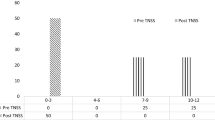Abstract
Allergic rhinitis is a global health problem and patients present with varied symptoms. The severity of symptoms is evaluated by a 5 point Nasal Obstruction Symptom Evaluation Scale (NOSE) and levels of absolute eosinophil count (AEC). A prospective observational study was conducted in 140 patients in a tertiary care hospital over a period of 1 year. A detailed clinical examination was performed, NOSE scale scoring based on symptomatology was done, and AEC values were assessed. Subjects were treated with intra nasal steroid spray and symptom evaluation done by NOSE scale at 3 months of use for follow up. NOSE scale and AEC values were correlated in our study. The mean NOSE 1 scale was 64.07 ± 16.71 in the study population, the mean AEC value was 633.07 ± 152.77. In our study correlation between intra nasal steroid spray and NOSE scale has been done. NOSE scale evaluation is simple, economical, and non-invasive. Therefore, it may be used in the management of allergic rhinitis.


Similar content being viewed by others
References
Asher MI, Montefort S, Bjorksten B, Lai CK, Strachan DP, Weiland SK et al (2006) Worldwide time trends in the prevalence of symptoms of asthma, allergic rhinoconjunctivitis, and eczema in childhood: ISAAC Phases One and Three repeat multicountry cross-sectional surveys. Lancet 368:733–743
International Rhinitis Management Working Group (1994) International consensus report on diagnosis and management of rhinitis. Allergy 49:S1–S34
Small P, Frenkiel S, Becker A, Boisvert P, Bouchard J, Carr S, Cockcroft D, Denburg J, Desrosiers M, Gall R, Hamid Q, Hébert J, Javer A, Keith P, Kim H, Lavigne F, Lemièr C, Massoud E, Payton K, Schellenberg B, Sussman G, Tannenbaum D, Watson W, Witterick I, Wright E (2007) The Canadian rhinitis working group: rhinitis: a practical and comprehensive approach to assessment and therapy. J Otolaryngol 36(Suppl 1):S5–S27
Dykewicz MS, Hamilos DL (2010) Rhinitis and sinusitis. J Allergy Clin Immunol 125:S103–S115
Tran NP, Vickery J, Blaiss MS (2011) Management of rhinitis: allergic and non-allergic. Allergy Asthma Immunol Res 3(3):148–156
Stewart MG, Wistell DL, Smith TL, Hannley MT (2004) Development and validation of the Nasal Obstruction Symptom Evaluation (NOSE) scale. Otolaryngol Head Neck Surg 130:157–163
Kumar N, Bylappa K, Ramesh AC, Reddy S (2012) A study of eosinophil count in nasal and blood smear in allergic respiratory diseases in a rural setup. Internet J Med Update 7(1):40–46
Hall JE (2016) Guyton and Hall textbook of medical physiology, 13th edn. Elsevier, Philadelphia
Gel PGH, Coomb RRA (1963) Clinical aspect of immunology, 1st edn. Blackwell, Oxford
Togias A (2004) Systemic effects of local allergic disease. J Allergy Clin Immunol 113:S8–S14
Patel AK, Nagpal TP (2014) Comparison of blood absolute eosinophil count and nasal smear eosinophils with symptoms and severity of clinical score in patients of allergic rhinitis. Ind J Allergy Asthma Immunol 28(2):74–77
Bellamkonda M, Vinodkumar G (2017) A clinic-pathological study of allergic rhinitis. Asian J Pharm Clin Res 10(1):186–191
Badorrek P, Hohlfeld JM, Krug N, Joshi A, Band M, Raut A (2015) Efficacy and safety of a novel nasal steroid, S0597, in patients with seasonal allergic rhinitis. Ann Allergy Asthma Immunol 115:325–329
Okano M (2009) Mechanisms and clinical implications of glucocorticosteroids in the treatment of allergic rhinitis. Br Soc Immunol Clin Exp Immunol 158:164–173
Bjermer L et al (2019) The complex pathophysiology of allergic rhinitis: scientific rationale for the development of an alternative treatment option. Allergy Asthma Clin Immunol 15:24
Funding
None.
Author information
Authors and Affiliations
Corresponding author
Ethics declarations
Conflict of interest
All authors declare that they have no conflict of interest.
Ethical Approval
Permission taken from institutional ethical committee for doing this study.
Additional information
Publisher's Note
Springer Nature remains neutral with regard to jurisdictional claims in published maps and institutional affiliations.
Rights and permissions
About this article
Cite this article
Dutta, A., Vallur, S., Arjun, A.P. et al. A Study on Role of NOSE Scale in the Management of Allergic Rhinitis. Indian J Otolaryngol Head Neck Surg 72, 234–238 (2020). https://doi.org/10.1007/s12070-020-01794-0
Received:
Accepted:
Published:
Issue Date:
DOI: https://doi.org/10.1007/s12070-020-01794-0




